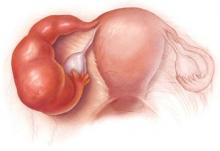Outpatient treatment of patients with mild pelvic inflammatory disease, using 1 g of azithromycin weekly for 2 weeks, combined with 250 mg of ceftriaxone intramuscularly on the first day, is superior to the current recommended treatment with doxycycline plus ceftriaxone.1
Strength of recommendation (SOR)
A: Single well-designed RCT
Savaris RF, Teixeira LM, Torres TG, Edelweiss MI, Moncada J, Schachter J. Comparing ceftriaxone plus azithromycin or doxycycline for pelvic inflammatory disease: a randomized controlled trial. Obstet Gynecol 2007;110:53–60.
Illustrative Case
An otherwise healthy, sexually active 21-year-old woman complains of pelvic pain for a week and yellow vaginal discharge. The history and physical exam are consistent with mild, uncomplicated pelvic inflammatory disease (PID).
You believe outpatient therapy is appropriate in this case and wonder if there is a better alternative to doxycycline, particularly given the challenges of adherence to the recommended 14-day course of treatment.
Background: 2 doses or 28 doses?
In the real world, we know that adherence is better when patients have to take 2 pills than when they have to take 28 pills. For most women with mild, uncomplicated PID, outpatient treatment is appropriate2 and a shorter treatment course is related to better adherence.3 Azithromycin can be given in 2 single doses a week apart, with few side effects, and its spectrum of activity is similar to that of doxycycline,4 which requires a 14-day regimen of 2 pills daily. Earlier studies of azithromycin for PID, however, were not designed specifically for outpatient treatment, or had methodologic bias.5 Thus, the evidence has been insufficient to recommend it.
PID affects about 1 million women in the US each year, and can cause pain, scarring of the fallopian tubes, and infertility.
Current recommendations. The Centers for Disease Control and Prevention (CDC) recommends oral doxycycline 100 mg twice daily for 14 days, along with a second- or third-generation cephalosporin administered parenterally, for mild PID in ambulatory patients.5 Metronizadole can be added at the provider’s discretion. The CDC no longer routinely recommends fluoroquinolones for PID because of gonococcal resistance.6 Dynamed, PEPID PCP, and UpToDate all cite CDC guidelines. Dynamed also notes results of the article reviewed here, though treatment recommendations were not changed.7-9
A simpler approach to pelvic inflammatory disease
Patients will likely find it easier to take 1 azithromycin pill initially and 1 pill a week later, than to take a doxycycline pill twice daily for 14 days. lf so, then the advantage of azithromycin could be greater than reported in this study
Clinical context: First comparison study, first outpatient study
The study by Savaris and colleagues is the first comparison study of azithromycin and doxycycline for PID, and the first study of outpatient treatment of PID with azithromycin.
An earlier study reported that women with PID who were prescribed doxycycline took an average of 70% of the total doses, and fewer than half took it twice daily as directed.3
Azithromycin is known to be effective for treatment of Chlamydia trachomatis cervical infections,4 and single-dose azithromycin has been also been shown to have better compliance than multidose therapy for Chlamydia infection.10
We identified only 1 prior randomized controlled trial of azithromycin for treatment of PID. That trial reported that intravenous azithromycin followed by oral azithromycin with or without metronidazole is effective in the treatment of PID.11
Study summary: Azithromycin cure rate 90%, doxycycline 72%
This randomized, double-blind, controlled study evaluated the effectiveness of azithromycin plus ceftriaxone in the treatment of mild, uncomplicated PID compared to doxycycline plus ceftriaxone, in outpatients.
Patients
The study enrolled 133 women who presented to an emergency department with PID diagnosed by the following clinical criteria:
- pelvic pain for less than 30 days
- pelvic organ (adnexal or cervical) tenderness on physical examination
- cervical leukorrhea or mucopurulent cervicitis.
Method
The women were randomized into 2 groups, and both groups received 250 mg of ceftriaxone intramuscularly.
- The control group received 100 mg of doxycycline twice daily for 2 weeks.
- The study group received 1 g of azithromycin by mouth weekly for 2 weeks and a placebo twice daily for 2 weeks to maintain blinding.
Outcomes
The primary outcome was clinical cure after 2 weeks of treatment. Clinical cure was defined as an improvement in pain scale ratings by 70%. Failure was defined as worsening of pain, lack of improvement of pain, or need for additional antibiotic therapy, hospitalization, or surgery.
Of the 133 women randomized, 13 (9 from the azithromycin group and 4 from the doxycycline group) were found to have diagnoses other than PID after randomization.
Intention-to-treat analysis was performed for the remaining 120 participants. In the azithromycin group, 56/62 (90.3%; 95% confidence interval [CI], 0.80–0.96) women were classified as clinically cured, versus 42/58 (72.4%; 95% CI, 0.58–0.82) in the doxycycline group.
Adverse events. Except for oral intolerance to the first dose of medication, which was similar in both groups, adverse events were not reported.


